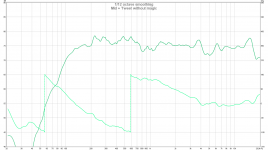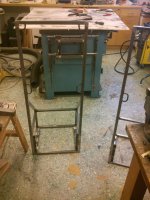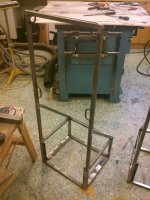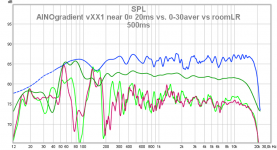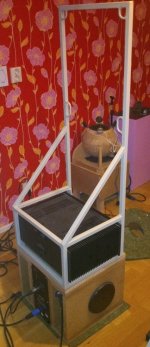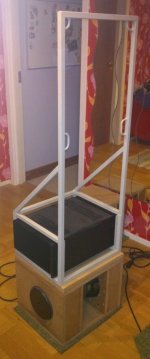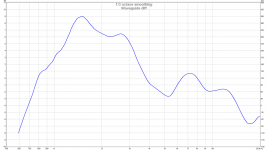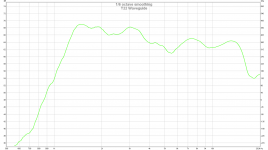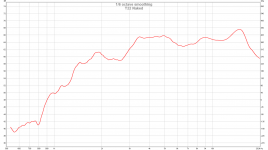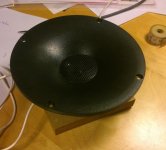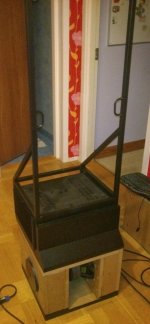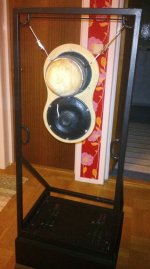I've done some more tests =)
The next step on the speaker is to build the real thing, the current plan is to weld together some steel pipe and mount the 10 inch and the midranges in pendulum swings.
But in the meantime... I have studied sorcery! Not really, but it seems that the MiniSHARC FIR magic really works =) The MiniSHARC will replace the 2x8. ( None of those filters are not final of course, I just did something fast to test how well it worked )
The next step on the speaker is to build the real thing, the current plan is to weld together some steel pipe and mount the 10 inch and the midranges in pendulum swings.
But in the meantime... I have studied sorcery! Not really, but it seems that the MiniSHARC FIR magic really works =) The MiniSHARC will replace the 2x8. ( None of those filters are not final of course, I just did something fast to test how well it worked )
Attachments
Soon, the next iteration is done and I can test with dual midranges where one is pointing to the front and one to the back. Both would have the DIY coaxial tweeter in front of them. I think it might just work with a wool baffle:
I decided to go with swings to mount the drivers, and the box on the bottom is to contain the amplifier driving the mid+tweeters =)
I decided to go with swings to mount the drivers, and the box on the bottom is to contain the amplifier driving the mid+tweeters =)
Attachments
High Ollboll,
Interesting The wool experiment for OB !
What did you put after the MiniShark for DAC, personal design or the littles ES90023 Minidsp modules (or hifimeDIY ones) ?
Interesting The wool experiment for OB !
What did you put after the MiniShark for DAC, personal design or the littles ES90023 Minidsp modules (or hifimeDIY ones) ?
High Ollboll,
Interesting The wool experiment for OB !
What did you put after the MiniShark for DAC, personal design or the littles ES90023 Minidsp modules (or hifimeDIY ones) ?
Currently I'm tinkering to get another SPDIF output from it, waiting for such a board which should arrive anytime now. The dac is an Audio-GD Reference 5 I bought a few years ago.
If I didn't already have that one I would probably get some WM8741-modules where I can connect the DAC output directly to my amp. Would be nice to make it completely integrated with those DACs on the speaker too =)
The sub + woofer is driven by one PSC2.400d on each side, which is fed the AES/EBU from the MiniSHARC.
I've done some more tests =)
The next step on the speaker is to build the real thing, the current plan is to weld together some steel pipe and mount the 10 inch and the midranges in pendulum swings.
But in the meantime... I have studied sorcery! Not really, but it seems that the MiniSHARC FIR magic really works =) The MiniSHARC will replace the 2x8. ( None of those filters are not final of course, I just did something fast to test how well it worked )
I just stumbled on this thread today. You are definitely doing some interesting stuff with this project! Not sure that I agree with some aspects, but you seem to be going at it the right way.
I have a question about the FIR corrections - I had a conversation with Siegfried Linkwitz recently about FIR flattening and phase alignment. He doesn't like it. He said that it is only good for one point in space (I think he is referring to phase alignment here but I am not sure). Are you using FIR only as EQ or also for phase? Can you take additional measurements with and without your FIR corrections at more than one angle so that we can see the effects of angle on the responses?
Thanks for posting your project as it has evolved. I will be starting to build an open baffle + U-frame system in the near future and this has giving me some thing to think about.
-Charlie
I've heard the same thing, I believe from the head guy over at Hypex. Also, maybe I'm just not understanding how you're using it, but another point is that: doesn't using EQ like this to compensate for room interaction affect steady-state signals differently than transient signals?
I just stumbled on this thread today. You are definitely doing some interesting stuff with this project! Not sure that I agree with some aspects, but you seem to be going at it the right way.
I have a question about the FIR corrections - I had a conversation with Siegfried Linkwitz recently about FIR flattening and phase alignment. He doesn't like it. He said that it is only good for one point in space (I think he is referring to phase alignment here but I am not sure). Are you using FIR only as EQ or also for phase? Can you take additional measurements with and without your FIR corrections at more than one angle so that we can see the effects of angle on the responses?
Thanks for posting your project as it has evolved. I will be starting to build an open baffle + U-frame system in the near future and this has giving me some thing to think about.
-Charlie
I'm using FIR as recommended by Bruno Putzeys, so I'm using IIR to flatten the response and do all the crossovers and FIR for phase correction only. According to Bruno this ensures that the drivers sum off-axis and you stop pre-ringing. If I'm not mistaken the biggest thing this solves isn't the frequency repsonse but rather the time response, if I remember correctly a linear phase response speaker has a perfect time response so no group delay which is nice.
When I have the next setup I might do just that and measure with and without. That which made me go on and decide to do it is that the phase response of 0-45 degrees are almost identical and 60 degrees is close, so a generic global phase correction should work.
Addition: I'm only fixing the phase errors of the low frequency roll off and the crossovers of the speaker itself. I won't use any EQ or phase correction for the room.
Last edited:
Ah, makes sense. So are you using IIR to flatten in-room response or just driver response anomalies? I still thought that EQ for flattening in-room response affects transients (more direct sound) differently than steady-state signals (more reflected sound) - will have to do some more reading on that.
Ah, makes sense. So are you using IIR to flatten in-room response or just driver response anomalies? I still thought that EQ for flattening in-room response affects transients (more direct sound) differently than steady-state signals (more reflected sound) - will have to do some more reading on that.
Driver and crossover anomalies only, I will EQ in as close to anechoic conditions I can. I will probably do outside measurements for the bass and gated for mid and upwards. My goal is to make the speaker approximate a dipole with symmetric front and back response.
How the actual room response will be I'll leave up to fate 🙂 though my tests show that the actual response in the room with dipoles is almost as good as anechoic.
Almost as good as anechoic? Nice! Looking forward to seeing it!
Yup, there is something about dipoles that integrate very well in rooms, at least my room =)
Kinda funny how fast I got converted into a believer of open baffled dipoles 😀
The measured room response similarity to anechoid/near is due to good direct/reflected ratio. Dipoles have quite high DI which reduces early sidewall reflectins. Late reflections are quite strong (backwave from front wall) but they are not detrimental to perception. This appplies only to a room that is quite large.
There are many people who don't like late reflections and of course the room's RT characteristics mean a lot too.
Some posts ago there was a question about room/driver eq. I also have eg'd only for nearfield (driver), nor for room response at all. Any eq does not change relation between direct and reflected sound!
Here are my AINOgradient measurements. It is dipole form 100Hz to 3500Hz. Nearfield at 1m speaker in the middle of the room. Average of 0-15¤ horizontal near measurements. Room at 2,1m and speakers some 80cm from front wall (usually considerd too near to wall for dipoles) and almost 45¤ toe-in. Toe-in is very important with dipoles to minimize early front-wall reflections.
There are many people who don't like late reflections and of course the room's RT characteristics mean a lot too.
Some posts ago there was a question about room/driver eq. I also have eg'd only for nearfield (driver), nor for room response at all. Any eq does not change relation between direct and reflected sound!
Here are my AINOgradient measurements. It is dipole form 100Hz to 3500Hz. Nearfield at 1m speaker in the middle of the room. Average of 0-15¤ horizontal near measurements. Room at 2,1m and speakers some 80cm from front wall (usually considerd too near to wall for dipoles) and almost 45¤ toe-in. Toe-in is very important with dipoles to minimize early front-wall reflections.
Attachments
The measured room response similarity to anechoid/near is due to good direct/reflected ratio. Dipoles have quite high DI which reduces early sidewall reflectins. Late reflections are quite strong (backwave from front wall) but they are not detrimental to perception. This appplies only to a room that is quite large.
There are many people who don't like late reflections and of course the room's RT characteristics mean a lot too.
Some posts ago there was a question about room/driver eq. I also have eg'd only for nearfield (driver), nor for room response at all. Any eq does not change relation between direct and reflected sound!
Here are my AINOgradient measurements. It is dipole form 100Hz to 3500Hz. Nearfield at 1m speaker in the middle of the room. Average of 0-15¤ horizontal near measurements. Room at 2,1m and speakers some 80cm from front wall (usually considerd too near to wall for dipoles) and almost 45¤ toe-in. Toe-in is very important with dipoles to minimize early front-wall reflections.
That looks about the same as what I got when I tested, the only difference is some minor ripple.
And here is some more progress... it got kinda big =)
Next step is to fix some MDF boards where they should be but after that it's time to test mount some drivers and do some measurements =)
Attachments
Moar progress!
I now have 2 of these, the missing parts is now the drivers, covering the bottom with purple upholstery fabric and then adding the wool baffle =)
I did some tests though on how to combat the rear null if I only use a single midrange so I bought a monacor WG-300 to test with. It's almost scary how much efficient the tweeter becomes exactly where the rear response of the midrange falls off. It just might work to use a single mid but with a waveguided tweeter on the back with a normal tweeter in the front.
I now have 2 of these, the missing parts is now the drivers, covering the bottom with purple upholstery fabric and then adding the wool baffle =)
I did some tests though on how to combat the rear null if I only use a single midrange so I bought a monacor WG-300 to test with. It's almost scary how much efficient the tweeter becomes exactly where the rear response of the midrange falls off. It just might work to use a single mid but with a waveguided tweeter on the back with a normal tweeter in the front.
Attachments
Great work OllBoll, I too have been bitten by the OB bug. 🙂
The OB bug is very contagious 😀
After doing some more thinking I'll probably test dual drivers first. Even if a back firing waveguide would conceptually work there is still the problem that I'm mounting it in a swing: I'd have to tinker with extra weights on the front to get the center of mass where I want it to...
If I use dual drivers it will automagically be in the middle which is nice 😀
Even moar progress!
I'll have to fiddle more with the 10 inch driver to ensure that the center of mass is where I want it to but it shouldn't be that much of a hassle.
Sometime in the not too distant future I will have it done, slab a sheet of wool on it and make some measurements =)
The tweeters are glued to the grille, much easier and better than my previous way of doing it which was screwing it to a shaped flat bar 😉
I'll have to fiddle more with the 10 inch driver to ensure that the center of mass is where I want it to but it shouldn't be that much of a hassle.
Sometime in the not too distant future I will have it done, slab a sheet of wool on it and make some measurements =)
The tweeters are glued to the grille, much easier and better than my previous way of doing it which was screwing it to a shaped flat bar 😉
Attachments
These are really taking shape! Are those wooden food bowls?
Yup, IKEA Blanda salad bowls =)
- Status
- Not open for further replies.
- Home
- Loudspeakers
- Multi-Way
- Dipole wool carpet baffle experiment
